In the exhilarating world of investing, the conversation often swirls around hot stocks, cryptocurrencies, or other tantalizing opportunities that seem like a fast track to prosperity. But amid the whirling dervish of market trends and financial news, one key principle maintains its rock-solid significance: optimal asset allocation.
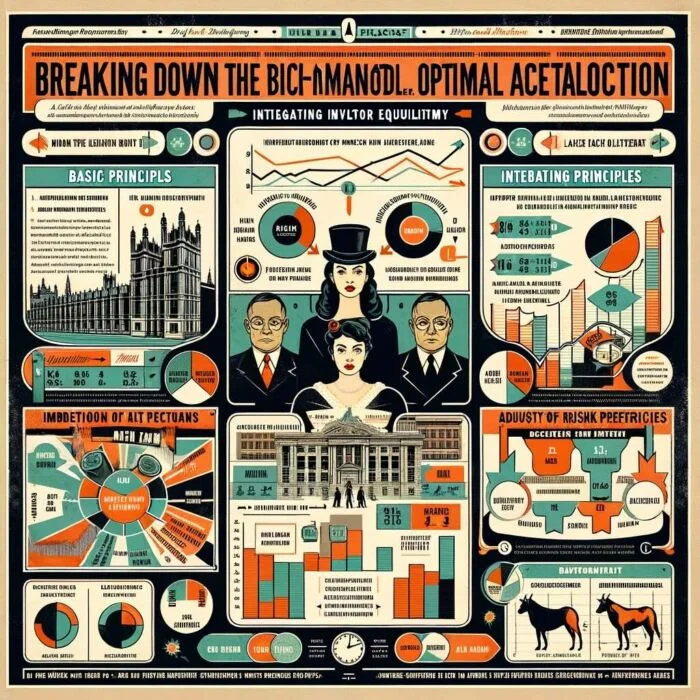
Optimal asset allocation is the foundation of successful investing, the unsung hero in a story often dominated by more glamorous characters. It is the practice of dividing an investment portfolio among different asset classes, such as stocks, bonds, and cash equivalents, to balance risk and reward based on an investor’s financial goals, risk tolerance, and investment horizon. Its importance cannot be overstated; it is the spine that holds together an investment strategy, underpinning the quest for a profitable return.
In our ongoing quest for the ideal asset allocation, various models and approaches have been put forward over the years. Some of you may remember Harry Markowitz’s Modern Portfolio Theory (MPT), which championed the concept of portfolio diversification to maximize returns for a given level of risk. MPT was groundbreaking for its time and continues to influence portfolio management today. But, like every other model, it is not without its limitations.

Optimal Asset Allocation: Black-Litterman Model
Enter the Black-Litterman Model. A bit like a hidden gem within the crowded treasure chest of financial theories, the Black-Litterman Model offers a unique approach to optimal asset allocation. The model was developed by Fischer Black and Robert Litterman at Goldman Sachs in 1990, and it shook up the investing world by addressing some of the inherent weaknesses of traditional models.
This article is a journey into the heart of the Black-Litterman Model. We’ll decipher its origins, delve into its mathematics, and explore its strengths and potential weaknesses. Whether you’re a seasoned financial analyst, an emerging investor, or simply an eager learner seeking to understand the economic forces that shape our world, this exploration will shed light on a vital piece of the asset allocation puzzle.
So, fasten your seatbelt as we embark on this financial exploration. Just as a sculptor chisely transforms a block of marble into a work of art, we’ll meticulously chip away at the complexities of the Black-Litterman Model, revealing the elegant structure that lies beneath. After all, in the realm of investing, knowledge truly is the most valuable asset.

Asset Allocation: A Primer
Like a skillful orchestra conductor coordinating a harmonious symphony of sounds, asset allocation is the art of balancing an ensemble of investments to create a perfectly tuned financial portfolio. It is the process of strategically spreading investments across various asset classes, such as equities, bonds, real estate, commodities, and cash equivalents. The goal? To diversify risk and maximize returns, akin to ensuring each instrument in the orchestra plays its part in crafting the ultimate symphony.
Asset allocation isn’t just a one-off act; it’s an ongoing strategy of financial composition and arrangement. It’s about making informed decisions and adjustments based on changing market conditions, individual financial goals, risk tolerance, and investment timelines. This process isn’t static—it dances to the rhythm of the financial market’s ebb and flow.
Importance in Investment Management
Now, why does asset allocation play such a pivotal role in investment management? The answer is twofold. First, the way your investments are distributed across different asset classes can significantly impact your portfolio’s overall risk and return. Second, according to a landmark study conducted by Brinson, Hood, and Beebower in 1986, it was found that over 90% of the variability of a fund’s returns over time can be attributed to asset allocation. Therefore, the artful juggling of investments across different asset types forms the backbone of any successful investment strategy.
Navigating through the vast universe of investment options can be akin to charting a course through a star-studded galaxy. There are numerous strategies for asset allocation to guide us on this cosmic journey. Let’s explore a few:

Various Strategies For Asset Allocation
- Strategic Asset Allocation: This is the ‘set-it-and-forget-it’ of allocation strategies. Based on expected rates of return for different asset classes, investors create a portfolio with a fixed allocation that aligns with their risk tolerance and investment goals. The portfolio is periodically rebalanced to maintain the original asset mix.
- Tactical Asset Allocation: This strategy allows more flexibility. Investors temporarily deviate from their strategic asset allocation to exploit market conditions or investment opportunities, adjusting the asset mix based on short-term market forecasts.
- Dynamic Asset Allocation: As the name suggests, this strategy involves constant adjustments. Investors continuously change the mix of assets in response to market or economic conditions, aiming to capitalize on emerging trends or dodge market downturns.
- Constant-Weighting Asset Allocation: In this strategy, investors regularly rebalance their portfolios. If one asset declines, they buy more of that asset, and if one asset increases, they sell it. This approach maintains a constant asset mix over time.
- Insured Asset Allocation: This is a risk-averse strategy. Investors establish a base portfolio value below which the portfolio should not be allowed to drop and if the portfolio’s value drops to the base, they invest in risk-free assets; if it rises, they invest in risky assets.
The universe of asset allocation is as wide and diverse as the starry night sky. But no matter what strategy is chosen, the core principle remains the same: balance. Just as a balanced diet is crucial for physical health, a balanced portfolio is vital for financial health. But achieving that optimal balance? That’s where the Black-Litterman Model enters our galaxy of discussion, offering its unique perspective on this universal challenge. Hold onto your space helmets, because we’re about to take a deep dive into its celestial mechanics.
source: NEDL on YouTube
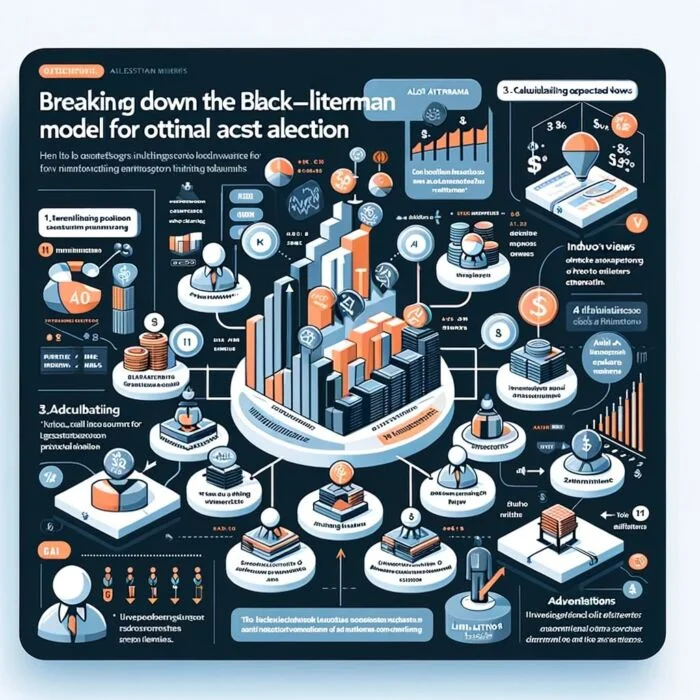
Traditional Models for Asset Allocation
Before we delve into the elegant complexity of the Black-Litterman Model, it’s essential to understand the landscape from which it emerged. This brings us to the doorstep of traditional models for asset allocation. Among these, none has cast a longer shadow or had a more profound impact than Harry Markowitz’s Mean-Variance Optimization Model, a concept that turned the investment world on its head in 1952.

Markowitz’s Mean-Variance Optimization Model
Markowitz’s Model, also known as Modern Portfolio Theory (MPT), is the equivalent of a classic novel in the literature of finance. It dramatically shifted the perspective from individual asset analysis to portfolio analysis, emphasizing the benefit of diversification. Instead of simply picking assets that were expected to perform well, MPT encouraged investors to consider how individual assets work together to affect the risk and return of the entire portfolio. In short, it championed the idea that the whole is more than the sum of its parts.
In the MPT model, the “mean” stands for expected return and the “variance” represents the risk associated with the asset. The model employs mathematical optimization to create a ‘efficient frontier’, a curve depicting the set of optimal portfolios that offer the highest expected return for a defined level of risk. It’s like finding the sweet spot in a pitch-perfect melody, the point where the notes of risk and return harmonize to create the most satisfying tune.
Despite the genius of Markowitz’s model, it’s not without its shortcomings. Just as a classic novel might reflect outdated societal norms, the Mean-Variance Optimization Model has limitations that have become more apparent in the face of ever-evolving financial markets. Let’s examine a few of these limitations:
Limitations of Traditional Models
- Over-reliance on historical data: The MPT model uses historical returns to predict future portfolio performance. However, past performance is not always an accurate predictor of future outcomes. It’s a bit like trying to drive by only looking in the rear-view mirror.
- Assumption of normal distribution: The model assumes that returns are normally distributed, which is not always the case in real-world markets. Outliers and extreme events, such as financial crises, can disrupt this assumption and lead to inaccurate predictions.
- Investor’s risk preference: MPT assumes that all investors are rational and risk-averse, aiming to maximize return for a given level of risk. However, human behavior often deviates from rationality, and individual risk preferences can vary widely.
- Single-period model: The model is designed for a single time period and does not account for multi-period investment horizons. This limitation can skew the asset allocation strategy for investors with long-term financial goals.
To put it metaphorically, while Markowitz’s model provided an excellent compass for navigating the financial seas, it wasn’t quite suited for the stormy and unpredictable waters of real-world markets. It’s these challenges that led Fischer Black and Robert Litterman to develop their own model, a model that aimed to take the baton from Markowitz and run with it further into the modern complexities of asset allocation. Enter the Black-Litterman Model, a new protagonist on our financial stage. And that, dear readers, is where our tale takes a turn towards a different horizon.
source: Phil Davies on YouTube
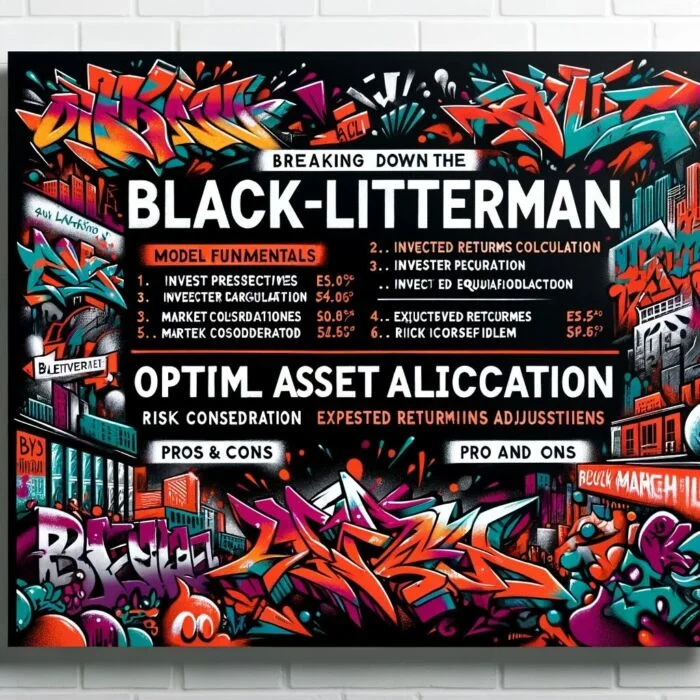
The Black-Litterman Model: An Overview
In the grand theatre of finance, where theories and models dance across the stage of time, a new act was unveiled in 1990 that stole the limelight. Developed by Fischer Black and Robert Litterman of Goldman Sachs, this act is what we now know as the Black-Litterman Model, a model that was built upon the shoulders of Markowitz’s Modern Portfolio Theory, aiming to tackle its limitations head-on and redefine the landscape of optimal asset allocation.

Origins of the Black-Litterman Model
If the stage of finance were an archipelago, Fischer Black and Robert Litterman’s model would be the sturdy bridge connecting the islands of theoretical finance and practical asset management. Created to improve the portfolio decision-making process within Goldman Sachs, the Black-Litterman Model didn’t merely patch the gaps in traditional models; it reimagined the entire process of asset allocation.
Now, let’s delve into the fundamentals of this revolutionary model. Picture a pair of glasses that not only corrects your vision but also lets you see the world in a way that is most meaningful to you. The Black-Litterman Model is similar, with two key components – the ‘global equilibrium’ and the ‘investor’s views’, working together to create an optimally personalized investment portfolio.
Basic Principles and Components of the Model
- Global Equilibrium: This is the starting point of the Black-Litterman Model. It assumes that the current market portfolio (the aggregate of all individual portfolios in the market) is an optimal portfolio reflecting the collective wisdom of all investors. This approach sidesteps the over-reliance on historical data that plagues traditional models, offering a forward-looking perspective instead.
- Investor’s Views: This is the second cornerstone of the model, where it truly shines. The Black-Litterman Model allows investors to incorporate their personal views about how they expect assets to perform. It’s like adjusting the color settings on your television to match your own preference, but in this case, the color settings are your investment returns, and the television is your investment portfolio.
By harmoniously combining these two elements, the Black-Litterman Model crafts an investment strategy that is both attuned to the global market equilibrium and personalized to the investor’s unique outlook. It is the perfect dance between global consensus and individual intuition, between the rhythm of the market and the beat of the investor’s drum.
Now, let’s circle back to how the Black-Litterman Model addresses the limitations of traditional models:

How the Model Addresses the Limitations of Traditional Models
- Mitigates the reliance on historical data: By starting from the global equilibrium portfolio, the Black-Litterman Model minimizes the dependence on historical returns, reducing the risk of skewed asset allocations.
- Overcomes the problem of estimation error: Traditional models, like the Mean-Variance Optimization Model, tend to give extreme weight to assets with slight changes in expected returns, leading to estimation error. The Black-Litterman Model reduces this issue by incorporating the investor’s views in a statistically robust manner.
- Enhances practicality and usability: By integrating personal views with market equilibrium, the Black-Litterman Model offers a more intuitive and practical approach to asset allocation. It provides a more tailored fit, making it more suitable for individual investors with unique preferences and expectations.
The Black-Litterman Model, in essence, can be seen as a humble revolution in the sphere of asset allocation. It’s like a quiet symphony that hits all the right notes, combining the melody of market equilibrium with the harmony of individual perspectives to produce a composition that resonates with the realities of modern investing. So let’s tighten our bow ties, raise the curtain, and immerse ourselves in the fascinating performance of the Black-Litterman Model.
source: CFA Society New York on YouTube
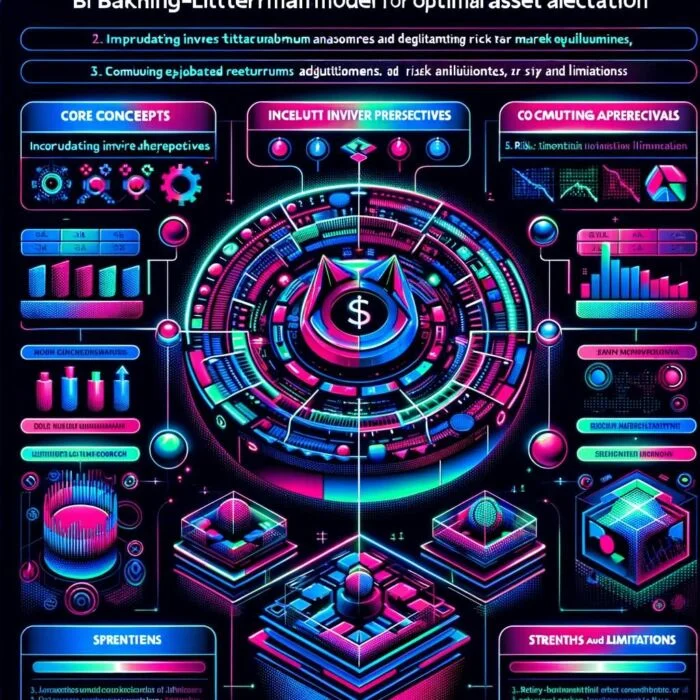
The Mathematics of the Black-Litterman Model
As we venture into the mathematics of the Black-Litterman Model, I’d like to assure you that, like exploring an intricate labyrinth, it may appear intimidating at first, but with a reliable guide and a dash of patience, the journey can prove immensely rewarding. So, let’s roll up our sleeves and delve into the world of equations, probability, and logic that underpins this financial marvel.
At its heart, the Black-Litterman Model leverages Bayesian probability, a mathematical framework for updating probabilities based on new evidence. It’s like a seasoned detective adjusting the likelihood of different hypotheses as new clues emerge. Bayesian thinking is what allows us to incorporate our views into the model while also considering the global equilibrium.
Now, let’s dissect the key mathematical ingredients of the Black-Litterman Model:
Breakdown of the Equations involved in the Model
- The Equilibrium Asset Returns: In the Black-Litterman Model, we begin with the concept of equilibrium asset returns. These are the returns of assets in the global market portfolio. Formally, we calculate these equilibrium returns using the formula:Pi = λ * Σ * WWhere: Pi is the vector of equilibrium returns, λ is the risk aversion coefficient, Σ is the covariance matrix of the assets, and W is the market-cap weight vector.Think of the equilibrium returns as the market’s collective ‘best guess’ of what each asset’s returns should be. They provide a neutral starting point for our asset allocation journey.
- The Investor’s Views: The Black-Litterman Model allows us to integrate personal views about different assets or portfolios into our calculations. Let’s say we have ‘k’ views. We then express these as a set of linear equations:Q = P * μ + εWhere: Q is a ‘k x 1’ vector representing the investor’s views on asset returns, P is a ‘k x n’ matrix that maps the investor’s views to the assets, μ is the ‘n x 1’ vector of expected asset returns, and ε is a ‘k x 1’ vector of error terms associated with the views.
- Combining the Equilibrium Returns and the Investor’s Views: Here’s where the Bayesian magic happens. We blend our equilibrium returns and our views to arrive at a combined return vector, using a set of equations that can be represented as:μ_BL = [(τΣ)^-1 + P’.Ω^-1.P]^ -1 . [(τΣ)^-1.Pi + P’.Ω^-1.Q]Where: μ_BL is the ‘n x 1’ vector of Black-Litterman expected returns, τ is a scalar representing the uncertainty in the prior (the equilibrium returns), Ω is the covariance matrix of the error terms in the investor’s views, Pi and Q represent the equilibrium returns and the investor’s views, respectively.
Bayesian approach in the model
In the grand equation of the Black-Litterman Model, the harmony between the equilibrium returns and the investor’s views creates a symphony of insightful asset allocation, under the watchful baton of Bayesian probability. By striking a chord between the market’s wisdom and the individual’s intuition, it provides a uniquely holistic framework for navigating the vast and volatile ocean of investment opportunities.
With the mathematical journey behind us, we stand on the other side of the labyrinth, equipped with a deeper understanding of the Black-Litterman Model’s inner workings. It’s this intricate network of calculations and probabilities that makes the model a formidable tool in the world of finance, providing a robust and flexible approach to optimal asset allocation.
source: eminshall on YouTube
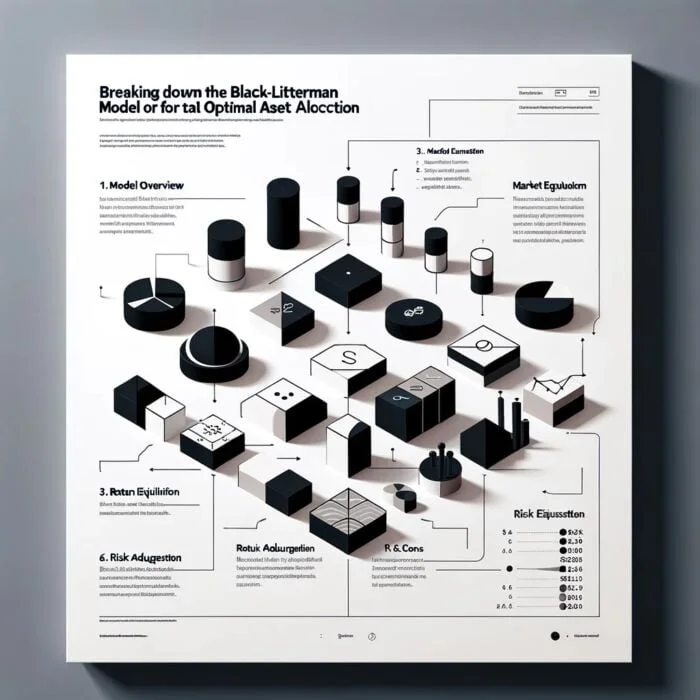
The Black-Litterman Model: A Step-By-Step Guide
Embarking on the implementation of the Black-Litterman Model is akin to embarking on an epic journey. A journey where we discover how to merge the wisdom of the crowd with our distinct perspective, to create a custom-fit investment strategy. So, fasten your seatbelt, and let’s get this show on the road!
Step 1: Calculating the Market Equilibrium Returns
The Black-Litterman Model begins by assuming the market portfolio is in equilibrium, with asset returns representing this equilibrium. We calculate these returns using the following formula:
Pi = λ * Σ * W
Consider we are working with a simplified market of two assets: stocks and bonds. Suppose we have estimated the risk aversion coefficient (λ) as 2.5, and the covariance matrix (Σ) and market-cap weights (W) for our two assets are:
Σ = | 0.04 0.02 | | 0.02 0.03 |
W = | 0.6 | | 0.4 |
Using these values, we can compute the equilibrium returns (Pi) for our portfolio.
Step 2: Defining the Investor’s Views
The second step involves formulating our views on the future performance of the assets. Suppose we hold the belief that stocks will outperform bonds by 3% in the upcoming period. This subjective view can be quantitatively expressed as:
Q = P * μ + ε
Given our view, the corresponding matrices Q (views on returns) and P (mapping of views to assets) are as follows:
Q = | 0.03 |
P = | 1 -1 |
The positive weight in P indicates that we expect a higher return from stocks, and the negative weight represents a lower expected return from bonds.
Step 3: Estimating Confidence in Views
Our confidence level in the views we hold is also an essential ingredient. This confidence level is represented by the variance of the error terms in our views (Ω). Lower variance signifies a higher degree of confidence. If we are highly confident in our views, we might assign a variance of 0.01, so Ω is:
Ω = | 0.01 |
Step 4: Blending Market Equilibrium and Investor’s Views
Now comes the time to blend the wisdom of the market with our personal insights. We use the formula to calculate the combined expected returns (μ_BL):
μ_BL = [(τΣ)^-1 + P’.Ω^-1.P]^ -1 . [(τΣ)^-1.Pi + P’.Ω^-1.Q]
The resulting μ_BL is a hybrid that marries the market equilibrium returns with our personal views. The weights given to each depend on our confidence in our views and the inherent uncertainty in the equilibrium returns.
Step 5: Determining the Optimal Portfolio Weights
The final step uses the Black-Litterman expected returns (μ_BL) in the context of Markowitz’s Mean-Variance Optimization to calculate the optimal portfolio weights. These weights represent a portfolio that is a balanced blend of market wisdom and personal convictions.
In conclusion, the Black-Litterman Model, just like any epic journey, may initially appear complex. But when broken down into distinct steps, it’s a remarkably practical and intuitive way to balance our individual insights with the wisdom of the market crowd. This optimal blending results in a more personalized and effective investment strategy, steering us closer to our financial goals.

Advantages of the Black-Litterman Model
Navigating the labyrinth of investing can be quite daunting. Deciding how to distribute your hard-earned cash across numerous asset classes requires a fair deal of wisdom, precision, and foresight. Here’s where the Black-Litterman Model steps in, serving as a reliable GPS on the winding roads of financial markets. Let’s delve into the significant advantages of this model that make it a trustworthy co-pilot in your investment journey.

Enhancing Asset Allocation Decisions
The Black-Litterman Model offers a quantum leap in the world of asset allocation, a leap that can lead investors from the choppy seas of uncertainty to the more serene waters of rational decision-making.
- Overcoming Estimation Errors: Traditional models, like Markowitz’s Mean-Variance Optimization, are extremely sensitive to input parameters, such as expected returns. Small changes in these parameters can lead to drastic shifts in the optimal portfolio, often yielding unrealistic portfolios heavily weighted towards a single or a few assets. This susceptibility is often referred to as the “error maximization” problem. The Black-Litterman Model mitigates this by starting with the assumption of market equilibrium, making the allocation less sensitive to estimation errors.
- More Rational Portfolios: The Black-Litterman Model leads to more diversified and intuitive portfolios. By incorporating the market equilibrium as a starting point, the model suggests allocations that are more in line with what one would intuitively expect given the market conditions, thus reducing the likelihood of extreme portfolio weights.

Flexibility to Incorporate Investor Views
- Incorporating Personal Views: The real charm of the Black-Litterman Model lies in its ability to merge the wisdom of the crowd with personal insights. It recognizes that each investor is unique, with distinct perspectives and expectations about market performance. The model provides an elegant way to incorporate these personal views and expectations into the portfolio optimization process.
- Quantifying Confidence Levels: In the financial world, not all views are created equal. Some are backed by thorough research and thus held more firmly, while others might be more speculative. The Black-Litterman Model embraces this reality. It allows for a quantification of the confidence level in the views, lending greater weight to views held with higher confidence while dampening the influence of less certain ones.
- Balancing Market Wisdom and Personal Views: The Black-Litterman Model doesn’t throw the baby out with the bathwater. While it facilitates the inclusion of personal views, it still respects the collective wisdom of the market, represented by the market equilibrium. By striking a balance between these two sources of insight, it provides a more nuanced and personalized approach to portfolio optimization.
In essence, the Black-Litterman Model is a bit like a bespoke suit in the world of asset allocation. It starts with a standard, market-consensus base but allows for customization based on an investor’s personal views and confidence levels. This fusion of personalized insights and market wisdom not only makes for a more intuitive and diversified portfolio but also provides a level of flexibility and robustness that sets it apart from traditional models. It’s the difference between a one-size-fits-all T-shirt and a tailor-made outfit, designed to fit your unique financial silhouette perfectly.
source: Finance Explained on YouTube

Limitations and Critiques of the Black-Litterman Model
Like any masterpiece, the Black-Litterman Model is not immune to critique. Indeed, it’s through understanding its limitations that we can truly appreciate its strengths and find ways to complement it. Picture the model as an exquisite piece of gourmet cheese; despite its nuanced flavors and luxurious texture, it may not be to everyone’s liking or suitable for all culinary endeavors. Let’s delve into some of the potential pitfalls and critiques of the Black-Litterman Model.
Potential Downsides and Critiques
- Complexity: Although the Black-Litterman Model offers a more sophisticated approach to asset allocation, its complexity can be daunting. The model involves several mathematical calculations and statistical nuances, making it potentially difficult for individual investors and even some professionals to grasp fully and implement correctly. Imagine trying to bake a gourmet cake without a clear understanding of the recipe!
- Subjectivity of Views: One of the unique strengths of the Black-Litterman Model – the ability to incorporate personal views – can also be a double-edged sword. Personal views are inherently subjective, and if not carefully considered, they could introduce bias or lead to overconfidence, which might skew the portfolio in potentially risky directions.
- Ambiguity in Determining Confidence Levels: The process of quantifying confidence in personal views presents another challenge. While the Black-Litterman Model allows investors to weight their views based on confidence, there’s no clear-cut guideline on how to do this. It’s much like trying to determine the perfect seasoning for a dish without a prescribed measure.
Limitations in Assumptions and Real-World Application
- Assumption of Market Equilibrium: The Black-Litterman Model assumes that the market portfolio is in equilibrium, which may not always hold true, especially in turbulent market conditions. Furthermore, defining the market portfolio itself can be tricky. Does it include only stocks and bonds, or should it also encompass real estate, commodities, cryptocurrencies, and more?
- Reliance on CAPM: The model relies heavily on the Capital Asset Pricing Model (CAPM) for determining the equilibrium returns. While CAPM is a widely accepted model, it comes with its own set of assumptions, such as investors being rational and markets being efficient. If these assumptions do not hold, the resulting equilibrium returns and subsequent portfolio allocations may be flawed.
- Difficulties with Non-Normal Distributions: Like many financial models, the Black-Litterman Model assumes that asset returns follow a normal distribution. However, real-world data often exhibit skewness and kurtosis, meaning returns can stray from this assumption. As a result, the model may underestimate the likelihood of extreme events or “black swans.”
The Black-Litterman Model, despite its numerous merits, has its quirks and foibles, much like a gourmet cheese with a strong aroma. However, by understanding these limitations, we can use the model more judiciously, pairing it with other strategies and measures to ensure we’re not only taking a delicious bite but also creating a balanced financial diet.

Case Study: The Black-Litterman Model in Action
The Black-Litterman Model isn’t just a beautiful theory; it’s been put to the test in the fierce arena of the real-world financial markets. Like a seasoned gladiator, it has stood the test of time, proving its mettle in a variety of circumstances. Let’s take a front-row seat and watch the model in action through these fascinating case studies.
Real-World Examples of Firms or Portfolios Using the Model
- Goldman Sachs Asset Management (GSAM): The Black-Litterman Model’s genesis can be traced back to Goldman Sachs, where Fisher Black and Robert Litterman first developed it. GSAM has long been known to use the model as a core component of its asset allocation strategy. Their robust global tactical asset allocation team utilizes the model to create dynamic investment strategies that account for market consensus and the firm’s views on various assets.
- Quantitative Investment Management Firms: Many quantitative investment firms, such as BlackRock, use the Black-Litterman Model in their strategic asset allocation. By integrating quantitative algorithms and the principles of this model, these firms have built investment strategies that fuse market wisdom with their unique forecasts.
- Robo-Advisors: With the advent of FinTech, many robo-advisory platforms, such as Wealthfront and Betterment, have adopted the Black-Litterman Model as part of their algorithmic investment strategies. These robo-advisors use the model to customize portfolios based on an investor’s risk profile and market conditions.
Outcomes of These Real-World Implementations
- Navigating Market Volatility: By blending market equilibrium with its own asset views, GSAM has successfully navigated turbulent markets. During the 2008 financial crisis, when markets were in disarray, the application of the Black-Litterman Model helped the firm achieve relatively better risk-adjusted returns than its peers.
- Improved Portfolio Diversification: Quantitative investment firms utilizing the model have shown a tendency toward better-diversified portfolios. This is a significant improvement over the often concentrated portfolios resulting from traditional optimization methods, which enhances risk management and can lead to improved long-term returns.
- Increased Customer Satisfaction: The personalized portfolios created by robo-advisors using the Black-Litterman Model have led to higher customer satisfaction. This personalization addresses a key desire of customers: a portfolio that reflects not just their risk profile but their unique market views.
These real-world applications underline the Black-Litterman Model’s effectiveness and versatility. Whether it’s a global investment giant like Goldman Sachs, a quant-driven firm, or a modern robo-advisor, the model’s adaptability has proven valuable in a variety of contexts. Just like a versatile actor who shines in every role, the Black-Litterman Model has shown it can deliver outstanding performances across different stages of the financial world.

The Black-Litterman Model: Future Perspectives
The Black-Litterman Model, with its strengths and quirks, is far from being a relic of the past. Instead, it’s continually evolving, much like a seasoned artist who consistently refines their craft. It stands at the intersection of traditional finance theory and the modern landscape of artificial intelligence and machine learning, creating a bridge between these two realms. Let’s explore what the future may hold for this dynamic model.
Recent Developments and Enhancements to the Model
- Black-Litterman and Alternative Data: In a world increasingly dominated by data, researchers and practitioners are exploring ways to integrate alternative data into the Black-Litterman framework. Social media sentiment, satellite imagery, credit card transactions, and more are being used to generate new views on asset returns, adding a fresh layer of depth to the model.
- Black-Litterman and ESG Investing: With the surge in Environmental, Social, and Governance (ESG) investing, the Black-Litterman Model is finding new applications. Investors’ ESG views are being incorporated into the model, allowing for portfolios that not only aim for financial returns but also align with societal values.
- Overcoming Limitations: Scholars have been actively developing variants of the Black-Litterman Model that seek to overcome some of its limitations. For example, some adaptations allow for non-normal return distributions, while others consider market frictions like transaction costs.

Future of Asset Allocation with the Rise of AI and Machine Learning
- AI-Driven Views: As AI and machine learning become more integrated into financial management, these technologies are being used to form views for the Black-Litterman Model. Sophisticated algorithms can analyze vast amounts of data, making predictions about asset returns that can then be incorporated into the model.
- Adaptive Confidence Levels: Machine learning could also help address the challenge of quantifying confidence levels in the model. AI could be used to analyze the past accuracy of an investor’s views, adjusting confidence levels based on this historical performance.
- Real-Time Portfolio Adjustment: With AI’s ability to process information in real-time, the Black-Litterman Model could be continually updated, allowing for dynamic asset allocation that keeps pace with the rapidly changing market conditions.
Imagine the Black-Litterman Model as a vintage car. The recent developments are like retrofittings that make it compatible with modern technologies, enhancing its performance while preserving its classic design. The rise of AI and machine learning, on the other hand, is like a state-of-the-art GPS system, guiding this vintage vehicle safely and efficiently through the complex maze of financial markets. With such exciting innovations on the horizon, it seems the journey of the Black-Litterman Model is far from over.

Conclusion: Black-Litterman Model
The time has come to drop the curtain on our deep-dive into the enigmatic world of the Black-Litterman Model. We’ve embarked on an odyssey through the intricate labyrinth of finance, exploring the past, present, and future of this pioneering framework. As we come full circle, let’s pause for a moment to reflect on our journey and the vital lessons we’ve gleaned.

Importance and Implications of the Black-Litterman Model
The Black-Litterman Model is no mere theoretical concept; it is a practical tool that has reshaped the landscape of asset allocation. Born out of a critique of traditional models, it’s a testament to the power of innovation, combining the wisdom of market equilibrium with the nuances of individual views.
It has offered a novel perspective on asset allocation, one that’s flexible, intuitive, and geared towards creating well-diversified portfolios. From Goldman Sachs to robo-advisors, its versatility has found favour across a broad spectrum of the financial world, proving its mettle time and again.
But the model isn’t resting on its laurels. It’s continually evolving, pushing boundaries, and exploring uncharted territories. Whether it’s incorporating ESG factors, integrating alternative data, or adapting to AI and machine learning, the Black-Litterman Model isn’t afraid to learn, adapt, and grow.
Final Thoughts and Key Takeaways
So, what does our deep dive into the Black-Litterman Model teach us? First, that innovation is the lifeblood of finance. The model represents a significant leap from traditional methods, proving that rethinking the status quo can lead to profound insights and improved outcomes.
Second, flexibility is crucial. The model’s ability to incorporate both market consensus and individual views showcases the importance of accommodating a range of perspectives in decision-making.
Finally, the journey is as important as the destination. The Black-Litterman Model’s evolution – from its initial inception to its ongoing enhancements – underscores the necessity of continual learning and adaptation in an ever-changing financial landscape.
As we draw this exploration to a close, we hope that the odyssey has been as enlightening for you as it was for us. The Black-Litterman Model, in all its complexity and elegance, serves as a powerful reminder of the beauty and dynamism of finance. May it inspire us to continue exploring, questioning, and innovating, as we navigate the intriguing waters of the financial world. Until our next deep dive, dear readers, stay curious and keep learning!
References For Curious Investors
- Black, F., & Litterman, R. (1992). Global portfolio optimization. Financial Analysts Journal, 48(5), 28-43.
- Idzorek, T. (2005). A Step-By-Step Guide to the Black-Litterman Model. IMA Journal of Applied Mathematics, 61(1), 15-23.
- Satchell, S., & Scowcroft, A. (2000). A demystification of the Black–Litterman model: Managing quantitative and traditional portfolio construction. Journal of Asset Management, 1(2), 138-150.
- Wang, P., Gonzalez, F., & Dyer, J. S. (2012). Modelling and estimation risk aversion in strategic decision making. Strategic Analysis of Risk, 3, 173-190.
- Atsalakis, G., & Valavanis, K. (2009). Surveying stock market forecasting techniques – Part II: Soft computing methods. Expert Systems with Applications, 36(3), 5932-5941.
- Das, S., & Chen, M. Y. (2007). Yahoo! for Amazon: Sentiment extraction from small talk on the web. Management Science, 53(9), 1375-1388.
- Eccles, R. G., Ioannou, I., & Serafeim, G. (2014). The impact of corporate sustainability on organizational processes and performance. Management Science, 60(11), 2835-2857.
- Friedman, J., Hastie, T., & Tibshirani, R. (2001). The Elements of Statistical Learning. Springer series in statistics, New York.
For further research and in-depth understanding of the Black-Litterman Model and its application in the real-world scenarios, these references provide a comprehensive collection of knowledge from leading academics and practitioners.
Important Information
Investment Disclaimer: The content provided here is for informational purposes only and does not constitute financial, investment, tax or professional advice. Investments carry risks and are not guaranteed; errors in data may occur. Past performance, including backtest results, does not guarantee future outcomes. Please note that indexes are benchmarks and not directly investable. All examples are purely hypothetical. Do your own due diligence. You should conduct your own research and consult a professional advisor before making investment decisions.
“Picture Perfect Portfolios” does not endorse or guarantee the accuracy of the information in this post and is not responsible for any financial losses or damages incurred from relying on this information. Investing involves the risk of loss and is not suitable for all investors. When it comes to capital efficiency, using leverage (or leveraged products) in investing amplifies both potential gains and losses, making it possible to lose more than your initial investment. It involves higher risk and costs, including possible margin calls and interest expenses, which can adversely affect your financial condition. The views and opinions expressed in this post are solely those of the author and do not necessarily reflect the official policy or position of anyone else. You can read my complete disclaimer here.






